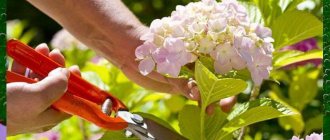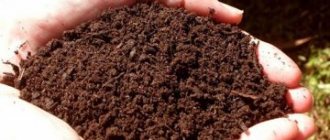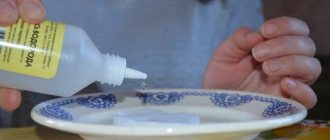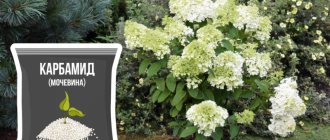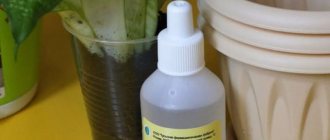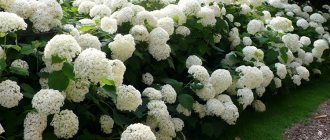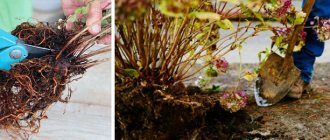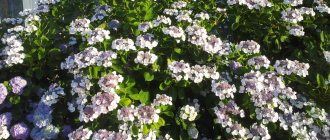Feeding hydrangeas with citric acid is an effective way to obtain the desired flower color. A feature of the plant is its preference for a slightly acidic soil environment. Hydrangea will not grow in alkaline soil. Not every gardener can provide the bush with natural conditions for development. To slightly acidify the soil and create the necessary conditions for hydrangeas to bloom, many people use citric acid. This feeding provides the bush with comfortable conditions for growth and does not require special knowledge or skill.
You can achieve such spectacular flowering using simple folk remedies.
What soil does hydrangea need?
The most favorable soil for hydrangeas is clayey, slightly acidic soil. It is this composition that guarantees lush flowering and rich color of the petals. Plants do worst in sandy or alkaline soil. Neutral soil allows you to grow hydrangeas whose inflorescences are light in color.
Hydrangeas - flowering shrubs
Depending on the acidity level, the color of the petals can vary from dark purple to pale pink. Experienced gardeners know how to achieve certain shades using various additives when watering. For example, manganese is used to produce pink flowers. An alternative solution is citric acid for hydrangea; the proportions are determined by the required color. Lemon and vinegar are used to create darker shades of blue. The dependence of flower color on acidity indicators is clearly shown in the table.
| pH | Coloring of inflorescences |
| 4 | Violet |
| 4,5 | Blue |
| 5,5 | Blue |
| 6,5 | Dark pink |
| 7 | Light pink |
It is important to know! To maintain the required color, maintain an appropriate level of soil acidity.
Soil acidity: what is it?
Until my three expensive rhododendrons died, I had rather vague ideas about soil acidity. I blamed the death of the plants on the weather, too much heat, the machinations of spider mites, and insufficient attention on my part, but I could not imagine that the soil was not suitable for the plants.
So what is soil acidity? This is a certain property of the soil, which is determined by the presence of hydrogen and aluminum ions in the soil composition.
| Name | pH indicators |
| Very strongly acidic | From 1.0 to 4.0 |
| Strongly acidic | From 4.1 to 4.5 |
| Subacid | From 5.1 to 6.0 |
| Neutral | From 6.1 to 7.4 |
| Slightly alkaline | From 7.5 to 8.5 |
| Highly alkaline | From 8.6 to 10.0 |
| Strong alkaline | More than 10.0 |
To grow most plants, neutral or slightly alkaline soils are required - the ideal pH is 5.5-7. Some species are able to thrive in slightly acidic soils. And only a small group of plants cannot live without acidic soil.
How to acidify soil for hydrangea
Soil for hydrangea - how to acidify soil for hydrangea
To acidify the soil, additives are used that are dissolved in water for irrigation. Depending on how much it is necessary to increase the pH level, substances with varying degrees of acidification are used. It is worth taking a closer look at how to acidify the soil for hydrangea.
Flower color depends on pH level
What composition of kefir is needed for hydrangea
Kefir, like all fermented milk products, is rich in phosphorus, nitrogen and potassium - elements necessary for any plant. The product contains a number of compounds that improve the fertile qualities of the soil:
- Amino acids.
- Proteins fats carbohydrates.
- Choline, beta-carotene.
- Lactose.
- Microelements (iodine, fluorine, copper, sodium, zinc, calcium, selenium, iron).
- Vitamins A, H, PP, C, group B.
Kefir contains lactic acid, which significantly increases the pH of the soil.
If for hydrangeas this is only for the better, then other plants located nearby may be negatively affected by such fertilizing. In addition to the beneficial properties for the flower, the good thing about the product is that it can be purchased at any store or supermarket. For the desired result, 2.5% kefir is suitable - it is just moderately sour.
Using popular tools
How to Change Hydrangea Color and Make Hydrangea Blue
Each method deserves special attention:
- Lemon acid. To obtain a solution, you need to mix 12 liters of water with 1 tsp. citric acid. Watering is carried out every 25-30 days to maintain the optimal acidity level. An alternative is to use lemon juice.
- Table vinegar. Use 9% essence, which is diluted in water in a ratio of 200 g per 20 liters. The method allows you to acidify the soil, but the effect is short-lived. It has been noticed that the use of vinegar negatively affects the soil microflora.
- Succinic acid. The use of this drug not only increases the acidity of the soil, but also serves as a fertilizer for the plant. The solution is prepared at the rate of: 3 tablets per 1 liter of water. If the drug is purchased in a different form, then you should adhere to the proportions on the package in order to feed the flower and not harm it.
- Apple vinegar. The solution is prepared from a bucket of water and 1 tablespoon of vinegar. Acidify the soil no more than once every 3-4 months. It significantly increases acidity and is less harmful than table vinegar. This acidifier still has a negative effect on the soil.
- Oxalic acid. Once every 1-2 months, watering is carried out with water containing oxalic acid, which is added in a ratio of 100 g per 10 liters. It is advisable to first dilute the required amount of crystals in a glass of warm liquid, and then add this solution to a bucket of water.
Popular means for soil acidification
Most gardeners prefer to use succinic and oxalic acid. Citric acid is often used for hydrangea. Vinegar is used less frequently due to its negative effect on the state of soil microflora. How to water hydrangea with vinegar and whether it can be done - each gardener decides for himself.
Note! It is important to strictly observe the proportions for preparing solutions. Failure to comply with them can lead to deterioration in the condition of the plants.
Recommendations and common mistakes
Fertilizing hydrangeas with citric acid is a fairly effective and safe way to balance the pH of the soil to provide optimal conditions for the plant. Beginners and even experienced gardeners sometimes make mistakes, which is why they fail to achieve the desired acidity level. Therefore, hydrangea acquires either a pale or too saturated color, close to purple, which has a bad effect on the development of the plant.
To maintain beautiful flowering, hydrangea is watered with an acid solution 4-6 times per season.
To prevent color deterioration, you must follow several rules:
- pH is measured periodically. This is especially important for saline soils, clay soils and other low-quality soils. To ensure the accuracy of the measurement, you should always have indicator paper on your farm, or even better, purchase a pH meter.
- Even if the soil has a normal acidity level in the range of 5.3-5.5, it will inevitably decrease over time. Therefore, even on good soils, acidification is done at least twice a season - during flowering and at the end of summer.
- It is important to note that the acidity level increases when certain fertilizers are added to the soil, for example, urea, ferrous sulfate or calcium nitrate. If these fertilizers are used, citric acid is given in smaller quantities. They bring it in less often.
- Instead of the main product, it is permissible to use oxalic acid, which can be purchased in stores for summer residents. The proportions and cooking instructions are the same.
- As for vinegar, although it is available, it is undesirable to use this product - the acid kills soil bacteria, including beneficial ones. Therefore, a few weeks after acidification, it is worth adding bacterial fertilizers, for example, Nitragin, Azotobacterin and others.
- If hydrangeas grow at home, they also require acidification of the soil, even if the soil was bought in a store or made from fertile soil. In this case, there is no need to prepare a whole bucket of solution - just take 10 g of powder per three liters of water.
- It is not recommended to store the prepared liquid for too long - it is better to use the solution immediately. If some volume remains, it can be stored for several days at room temperature (in the absence of direct sunlight).
- Don't forget about other care activities. Hydrangea is a rather demanding plant that requires regular watering, fertilizing, loosening and weeding. Preparation for winter is equally important, especially for large-leaved varieties.
Read more How to propagate paniculate hydrangea by cuttings in spring at home
Application of mineral oxidizing agents
Why do hydrangeas have small inflorescences - reasons and solutions to the problem
Preparations such as colloidal sulfur and sulfates are used to oxidize heavy clay soil. They have a strong and long-lasting effect. Features of application:
- Colloidal sulfur. The drug is applied in dry form under each bush at the rate of 30 g per 1 m². The surface of the soil is loosened and the powder is buried 15 cm. The method is used in the fall so that its activation begins in the spring under the influence of melt water. It is enough to add sulfur once every 2 years.
- Sulfates. Iron sulfate is used in the amount of 50 g per 1 m² of area. Apply dry in the fall directly to the soil. Sometimes ammonium sulfate is used (at your own risk).
- Ammonium nitrate and potassium sulfate. The drugs are relevant only when the deviation from the norm is insignificant. A solution of nitrate is prepared at the rate of 30 g of the drug per 10 liters of water. Apply under each bush in spring or autumn.
Helpful information! It is better to use mineral oxidizing agents as rarely as possible. Frequent application of such drugs can harm plants.
Advantages and disadvantages
Advantages of the product:
It is difficult to identify the disadvantages of the product - no contraindications or negative reactions have been recorded.
However, there are features of the action and use of the drug:
it is important to study the instructions and follow the recommendations when diluting mixtures; take into account expiration dates and storage conditions (information is written on the packaging); It is not advisable to dilute the solutions before processing; it is not advisable to leave the finished mixture in reserve - the beneficial properties are retained for 3-4 hours;
Organic acidifiers
There are several methods for making the soil acidic for hydrangeas. They involve adding natural components to the soil or mulching the surface around the plants.
Natural products are environmentally friendly and safe
Current tips:
- Leaf humus. It is preferable to use rotted oak leaves. Adding compost to the soil increases acidity and also enhances its nutritional value.
- Larch needles. Coniferous tree needles are used to mulch plantings.
- High peat. It is used as mulch or added to the soil for planting hydrangeas. Acidity increases significantly, but the process will take some time.
Methods that involve the use of organic matter to acidify the soil are environmentally friendly and beneficial. The only drawback is the delay in action. For this reason, humus or peat is added to the site in advance.
Additional Information! High-moor peat should only be used to acidify the soil. Only lowland peat is suitable as mulch or fertilizer for flowers.
How to prepare soil for garden hydrangea
Despite the fact that there is an opinion that hydrangea can grow on any soil, it is still necessary to make an effort to prepare the soil before planting to obtain a chic bush. Important criteria are:
- nutritional value;
- ease;
- water conductivity;
- acidity (pH composition).
Note that hydrangea loves slightly or moderately acidic soil, the optimal pH level is 5.5. This criterion must be monitored and under no circumstances should the soil be limed before planting hydrangeas, but rather, if necessary, acidify it. This is done using organic food acids. Most often, an aqueous solution of citric acid is used at the rate of one teaspoon per ten liters of water. Citric acid can be replaced with malic, oxalic or acetic acid. The color of hydrangea inflorescences indicates the level of soil acidity. If the bush is covered with pink flowers, then the soil is slightly alkaline, but when the inflorescences are blue, dark blue or deep purple, then this indicates that the soil is acidic. Many experienced gardeners use this feature of hydrangeas and quite successfully regulate the color scheme of hydrangeas, using watering with organic acids.
Soil acidity is also regulated by applying fertilizers. This can be ammonium sulfate, potassium sulfate, iron sulfate. Sulfuric acid acidifies soil well. Ten liters of water require no more than five milliliters of the drug. The bush can be watered with this solution several times a season. Experienced gardeners use some tricks that help them grow a bush with colorful inflorescences. To do this, they water the hydrangea on one side with solutions to acidify the soil, and on the other hand, on the contrary, add lime. With such actions you can achieve an excellent result when large inflorescences of pink and blue flowers flaunt on one bush.
Now a few words about the composition of the soil. The soil for planting must be prepared in advance. Therefore, first of all, a plot of land should be dug up and a sufficient amount of organic matter and minerals should be added. Humus or peat are used as organic fertilizers; superphosphate can be used as mineral fertilizers. Then you need to prepare planting holes with a drainage layer and substrate. The soil for planting hydrangeas is best prepared from black soil, turf, peat, humus and river sand. All components are taken in equal parts. The prepared substrate is poured into the planting holes and allowed to settle. Just before planting the seedlings, special fertilizers are added to the soil to acidify them; these can be preparations like Kemira, Acid Plus and others.
In order for the soil to retain moisture longer after planting the seedlings and receive additional nutrients, it is necessary to mulch the root circle with humus or peat. The mulch is periodically updated.
Since hydrangea loves nutritious soil, applying fertilizer is of great importance for the full development of the bush.
The first feeding is carried out in early spring before the start of active growing season, the second during the formation of buds. Then, throughout the summer season, the hydrangea is fed every two weeks. The last feeding of the season is carried out in the fall, after flowering.
The plant responds quite well to complex mineral fertilizers, and before preparing for the winter season, it is best to feed the bush with a urea solution in a ratio of twenty grams of the substance per ten liters of water. On average, one adult bush requires up to thirty liters of liquid. After feeding, the hydrangea should be mulched with humus or peat.
From everything written above, let’s summarize briefly. Hydrangea needs nutritious and acidic soil, which should be moist, but not excessively, and well-drained. Compliance with the basic requirements for cultivation will allow you to get maximum results with little effort.
Soil oxidation technology
It is important to follow a strict sequence of actions aimed at increasing soil acidity. Initially, the pH level is determined by using litmus paper. It can be purchased at any garden center and measurements are taken according to the instructions included with the product. There are several rules:
- to slightly increase acidity, use a solution of citric acid or ammonium nitrate;
- Vinegar and citric acid will help quickly improve performance;
- You can safely acidify the soil by adding high-moor peat or oak leaf compost to the soil.
Some substances are dissolved in water, and some preparations are embedded in the soil in the fall in dry form. It is necessary to strictly observe the proportions; watering the tree hydrangea with citric acid and other solutions is carried out only at the root. The key to success is adherence to technology. Otherwise, home flowers will be damaged.
Failure to comply with proportions leads to plant diseases
Purpose of acidification
The acidity level affects the color of the buds:
Watering hydrangea with citric acid proportions
- increased - gives hydrangea flowers blue, purple, blue color shades;
- neutral - colors the petals white or beige, they become less bright;
- alkaline - makes them pink, lilac (large-leaved (garden) hydrangea has this feature, while in paniculate and tree hydrangea only the color intensity can change).
Help: hydrangea with petals of a greenish tint never changes its color.
The procedure is also necessary for a number of other reasons:
- the plant absorbs fertilizers only through acidified soil, without actually accepting them from neutral soil;
- with an acidity coefficient of 5.5 pH, the culture grows better;
- the inflorescences are more lush, healthy, and attractive in appearance.
Litmus paper (sold in special stores) helps to find out the balance of the soil. You can also use a vinegar solution (9%). The soil is loosened and a small amount of product is poured onto it. Alkaline soil will be indicated by the appearance of characteristic foam.
The beds are acidified until the acidity coefficient is established within 4.5 - 5.5. How long this may take depends on the soil: loose soil or black soil acidifies more easily, but on heavy and clay soils the process is slower.
How to maintain the resulting acid-base balance
As paniculata hydrangea grows, the acidity of the soil in the area changes. Indicators may deviate from the norm. To maintain pH at a given level, watering with solutions of citric, succinic and oxalic acid is used. The preparations are able to maintain the acid-base balance, favorable for hydrangeas.
Mulching with peat and pine needles throughout the entire period of growth and flowering helps to increase acidity. The mulch layer is updated annually, replacing the substrate completely or thickening its layer. This rule also applies to oak leaf compost, which is used to mulch plantings.
The mulch layer needs to be updated
What can replace vinegar?
There are several options for replacing vinegar:
Organic compost from leaves; rotted sawdust and pine litter; peat moss (sphagnum); manure (fresh only). 1. Acidification occurs slowly. 2. The effect remains for a long time. 3. Maintains soil looseness, feeding it with additional minerals. Minerals ammonium sulfate; ammonium nitrate; ferrous sulfate; potassium sulfate; colloidal sulfur. 1. Significantly increases acidity in a short time. 2
Chemical compounds are used with caution, as they can cause the opposite effect. Green manure oats; lupine; soy; mustard; rape. 1. Planting such plants near hydrangeas maintains soil acidity.
Means for increasing the amount of alkali
Sometimes there is a need to return the acidity level to its original values. This is usually due to the fact that other plants that prefer a more alkaline environment are supposed to be planted in the place where hydrangeas grow. In this case, there is a need for soil deoxidation. Lime is most often used for this purpose.
Liming the soil involves a number of actions:
- Ground limestone is poured into a barrel, pot or other container and filled with water. 1 part limestone requires 10 liters of water.
- The soil is watered with lime infusion. After 2-3 days, they begin sowing or planting plants.
Chalk can be used instead of lime. The main condition is that it is applied in the spring before harrowing. Use crushed dry chalk, which is used at the rate of 100-200 g per 1 m². The amount of the substance depends on the degree of acidity of the soil and the indicators to which it must be reduced.
Dolomite flour can be used as an alternative to lime, but this is not safe. For some crops, such deoxidation is harmful.
Note! Dolomite flour should not be added to the area intended for gooseberries, sorrel, blueberries and cranberries.
Hydrangeas have special soil requirements. Alkaline soil is not suitable for them - they prefer acidic and slightly acidic soils. In most cases, it is necessary to artificially increase the acidity level and maintain it throughout the life of the plants. You can use different methods, but each gardener decides for himself how to acidify hydrangea.
Hydrangea care
Grooming rules are linked to specific cultural preferences. Garden hydrangea requires regular watering and a special substrate. In addition, she loves light and warmth, and is also picky about her neighbors.
Placement
For hydrangea, choose places near a hedge, fence, or on the south side of the house. The open area should not be shaded by the crowns of tall trees. Young bushes must have enough space to grow. Neighboring crops are chosen taking into account that the roots do not grow in width and do not compete for food and moisture. Avoid planting in areas with strong winds. Bushes can grow up to 4 m, so a strong wind can break branches and damage inflorescences.
Lighting
An important point when choosing a location. The shrub is demanding of light: in the morning it needs full sunlight, in the afternoon partial shade is preferable. The scorching sun causes the flowers to shrink and wilt.
Watering
Hydrangea needs regular watering. In summer, when the air temperature exceeds + 27-28°, watering is daily. The soil is moistened in the morning by root watering. In the evening, water the bushes by spraying or sprinkling. The bushes are not resistant to drought, and also do not tolerate stagnant water, so planting in lowlands where moisture accumulates is excluded.
Feeding
To establish lush flowering, follow the feeding schedule. In spring, the soil is fertilized with organic matter. Then mineral mixtures are added to increase the green mass and form buds. At the peak of flowering, organic matter is added again. The type of mixture and frequency of fertilizing completely depend on the composition of the soil. Some elements of mixtures affect the alkalization of the environment, which is detrimental to all species, so avoid adding dolomite, limestone, and chalk.
Trimming
One of the important conditions for crop care. In the spring, formative pruning must be carried out. The buds of young bushes are cut off, this stimulates budding; old bushes are given rejuvenating pruning. Bushes are often shaped like balls (large-leaved, tree-like) or elongated candles (paniculate).
Mulching
Agrotechnical practices carried out to retain moisture inside help to simultaneously maintain soil acidity levels. For a layer of mulch, use pine needles, pine bark or high-moor peat.
Loosening
Regular loosening of the top layer helps to increase the conductivity of air and moisture, which is especially important for the crop. The soil under the bushes is loosened after heavy watering, after rains, combined with changing the layer of mulch
Reproduction
The bushes are divided, propagated by cuttings or layering. Planting rooted cuttings begins with preparing the soil.
Advice! The bushes are pruned in stages: the main pruning is done in the spring, and adjustments are made in the fall. In summer, branches that develop inside the bush are pruned.
About the flower
Hydrangea is a plant that belongs to the Hydrangeaceae family. There are about 70 varieties of the flower, but 10 types are most commonly used. In the Russian Federation, tree and paniculate hydrangeas are grown, and large-leaved plants are also very often planted. Colors, sizes, shapes, etc. depend on the type of flower.
Attention: When planting hydrangea, you need to choose the right location for it, since children should not get close to the bush, because it produces cyanide acid, which is hazardous to health.
It happens that the leaves of the plant begin to acquire a yellow tint. This is a direct sign of lack of humidity. Hydrangea needs to be constantly watered to avoid this phenomenon. Most often, the plant is grown at home, but nowadays there are many varieties that are not afraid of frost, but require preventive shelter for the winter.
The flower is loved by landscape designers; hedges and gardens are often decorated with hydrangea. The plant can be planted with a variety of neighbors, which must be chosen very carefully.
Attention: Hydrangea should be planted next to plants that do not have a superficial root system.
Fertilizing indoor hydrangea
The leaves of hydrangeas growing indoors awaken earlier. Accordingly, fertilizing begins immediately after planting and the plant emerges from the dormant period, in mid-late February. Early spring fertilizing, as in the case of open ground, is aimed at saturating it with nitrogen. Use any mineral fertilizer with a high content of this microelement. It is better not to add organic matter to the pots - the parts that have not decomposed will begin to rot, which will provoke the intensive development of pathogenic microflora. You can stimulate the growth of leaves and side shoots by spraying the bush with a solution of succinic acid. The working solution is prepared according to the manufacturer's instructions, since it can be of different purities, and accordingly, the dosages may differ
In pots, “gluttonous” hydrangea will need more feeding, at least 2 per month. Nutritional needs are easy to determine - if the leaves of a hydrangea turn light, it means you are not fertilizing it enough. In spring and summer, as for open ground plants, phosphorus and potassium should predominate in fertilizing. In autumn, fertilizers should contain potassium and iron.
Types of hydrangea flower
Hydrangea is a medium-sized heat-loving shrub (some varieties can grow as small trees). The plant belongs to the Hydrangeaceae family. Abundant flowering occurs in summer. If the planting site is incorrectly selected, untimely feeding and insufficient watering, deterioration in flowering, a sharp decrease in the size of flowers, and premature wilting of inflorescences can be observed.
There are 3 main types of hydrangeas:
- Paniculata is an unpretentious winter-hardy shrub. The inflorescences are large (up to 30 cm in length). Flowering is observed in the second ten days of summer with white inflorescences, gradually acquiring a pink color closer to autumn. Varieties of this species do not change color depending on the applied fertilizers.
- Tree-like - drought-resistant, frost-resistant lush bush, with large leaves, up to 1.5 meters high. Blooms from mid-July to August.
- Large-leaved is the most common species that decorates the garden of amateur gardeners. Breeders have developed various varieties with double (needle-shaped) flowers in white, pink, blue, red, and purple shades. A peculiarity of this type of hydrangea is that the color of the flowers changes when certain types of fertilizers are applied. However, this species is especially sensitive to temperature changes and requires shelter even in light frosts. Therefore, even if the plant has overwintered, but the upper buds are exposed to frost, flowering may not occur.
If you want to plant a hydrangea bush in your garden, it is important to know about the characteristics of each type and variety of plant in order to enjoy lush, luxurious flowers of various colors
FAQ
To clarify the most important points, we will answer the most frequently asked questions.
What happens if you over-acidify the soil?
Vegetable crops will not grow on acidified soil, but hydrangea feels good. If the acidity index is below 4, then think about the opposite action - increasing the amount of alkali.
How to fix the situation after watering
The following will help increase the amount of alkali and reduce the acidity in the soil:
- dolomite flour;
- slaked lime;
- chalk;
- wood ash.
Information on neutralizing soil after severe acidification:

